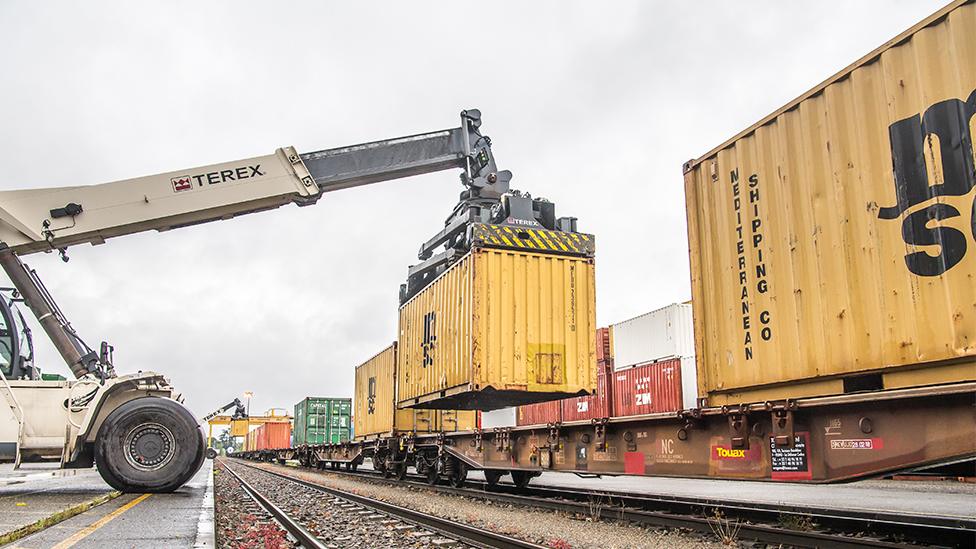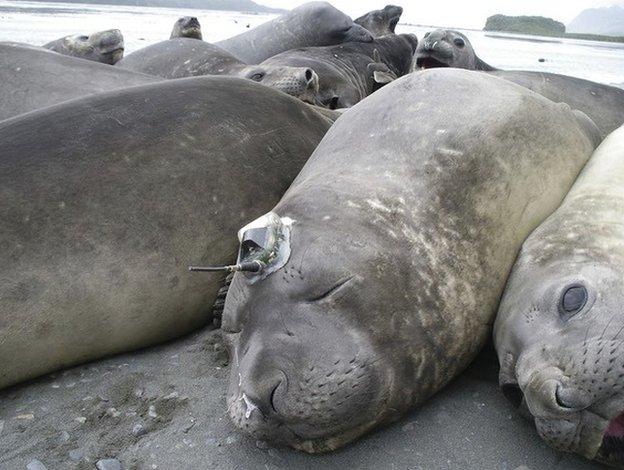'Internet of animals' spreads its wings
- Published

Connecting up all objects will improve the efficiency of supply chains
The French satellite system ARGOS that for 30 years has been used to track animals across the globe is getting a major overhaul and expansion.
A new company, Kinéis, will take over its operation and launch 20 small satellites to start tracking objects of all kinds as well.
There is a growing market for services that manage connected devices.
Kinéis would be the first European satellite constellation dedicated to this so-called Internet of Things.
The commercial initiative would see beacons, or terminals, attached to all manner of objects, from vehicles and shipping containers to remote, unattended machinery and even livestock.
IoT services allow users to monitor the status of their assets and better manage their movements, for example in supply chains.
"Today ARGOS has about 20,000 beacons around the globe, external and our mission now is to multiply this by 50 to 100 in the next 10 years. And to do that we will diversify our markets and applications," project leader Alexandre Tisserant told BBC News.
How does tagging and tracking work?

The existing Argos system will transfer to the new Kinéis constellation, and be upgraded
Kinéis will be working with manufacturers to produce hundreds of thousands of small transmitters that can bounce simple messages off its satellite network.
A new computer chipset is being produced that can be used in these beacons. Unlike the existing ARGOS chipsets, the new processor will also permit two-way communication, to change electrical settings on a piece of remote equipment, for instance.
Kinéis has been created by CLS (Collection Location Satellites), external of Toulouse, which has run ARGOS - a kind of "Internet of Animals" - since 1986.
ARGOS has enabled scientists to attach small tags to animals to track and study their movements.
The creatures, such as birds, polar bears, seals, and turtles, report their position and simple data on their environment.
CLS, with its partners, including the French space agency, CNES, intends now to take this system to a whole new level.
Kinéis, also based in Toulouse, will assume the operation of ARGOS and introduce many more services to be run across its coming constellation.
What does a new system like this cost?

Kinéis is looking to build services that operate at very low cost
Franco-Italian manufacturer Thales Alenia Space, which is expert in building space networks, has been engaged to lead a consortium to provide the new shoebox-sized satellites.
A final price has yet to be agreed, but the fabrication, launch and operation of these spacecraft (including a further 20 spare satellites for later use) is likely to require funding somewhere in the region of €100m.
Kinéis expects to put up a test platform next year and then have the full constellation in orbit by the end of 2021.
The satellites would circle the Earth in five planes at an altitude of 600km.
Technology explained: What is the internet of things?
Key to success will be finding and developing low-cost applications, predicts Mr Tisserant. He cites examples such as west African fishermen who cannot afford overly sophisticated transponders to identify their small boats, and the reindeer herders of Siberia who live a subsistence existence but who could still benefit enormously from being able to track their animals.
"There has been a drastic reduction in the cost of launching things into space thanks to nanosatellites, which measure say 20cm by 20cm by 40cm and weigh only a few kilograms. These are completely different to the old type of expensive satellites," he said.
"Together with the mass production of beacons, we can lower the price. This is one of our main ambitions - to democratise these technologies. It has to be this way to be successful, otherwise they will remain in the hands of a few rich institutions or for very specific needs."
Who else is doing this kind of thing?

Any such system will have to operate at scale - which is a challenge
The Kinéis announcement was made on Monday morning at World Satellite Business Week (WSBW), external - the major annual satellite conference in Paris.
WSBW brings together the executives of all the big satellite companies to discuss the state of the industry. IoT has been an expanding theme in their deliberations for a long time.
There are existing players already well established in the sector with whom Kinéis will have to compete. These include the American companies Orbcomm, which has more than a million active subscribers for its services, and Iridium, which started out as a satellite phone company but which is now putting on substantial growth in the arena of connected devices. And, unsurprisingly, there are other recently started wannabes with similar propositions, such as Adelaide-based Fleet Space Technologies and Toronto-headquartered Kepler Communications.
Some of the predictions for the future value of IoT connectivity appear a little extreme, with talk of the market being worth trillions of dollars by 2030. But however big it eventually becomes, the space segment will only ever be a small fraction of the total because most tagging and tracking devices will use terrestrial networks, even if that is just the cellular phone system.
What do you need to succeed in this business?

Connection via satellite will be a small part of the IoT sector
Pacôme Révillon is the Chief Executive Officer of Euroconsult, the analysts who organise WSBW, external. He says it depends on your precise definition of IoT but there are presently some four million satellite terminals attached to the likes of trucks and goods shipments, transmitting low-data messages about their status and position.
Euroconsult's assessment is that this could grow to 10 million terminals in the next 5-10 years.
"There are significant challenges for new companies," Mr Révillon says. "To operate as a global company - if you are a start-up, you will need to find the right partners that have the access or to be hugely efficient to distribute your service.
"CLS/Kinéis already has a certain level of exposure and experience thanks to ARGOS which will be an advantage. Distributing your service is a key challenge and that is true for all of the coming satellite constellations, be they in IoT, Earth observation or broadband internet."
Euroconsult college and IoT specialist Juliette Caillault added that getting the design right of the beacons was paramount: "Power consumption is also a really important point. It's really important to have terminals that do not use too much. Battery life on the terminals can also really drive this market."
Jonathan.Amos-INTERNET@bbc.co.uk, external and follow me on Twitter: @BBCAmos, external